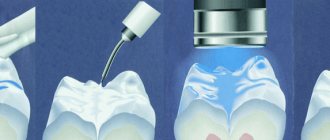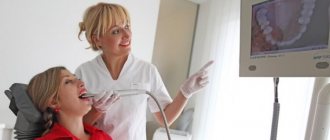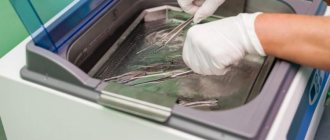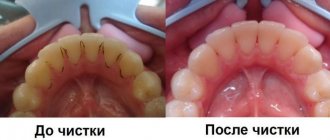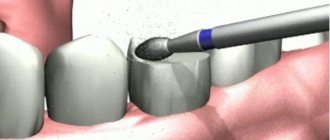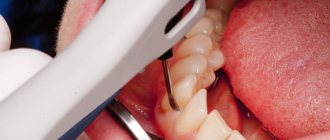Orthopedic dentistry is one of the areas of dentistry that deals with the study, diagnosis and treatment of disorders in the dental system. Various types of prosthetics and installation of regulating structures for teeth are the main activities of an orthopedic dentist.
General orthopedics, dealing with the treatment of skeletal deformities and restoration of bone tissue, became the impetus for the emergence of orthopedic dentistry, when the problem of restoring lost teeth and bone tissue of the jaws became acute.
The emergence and development of prosthetic dentistry dates back to the end of the 19th century. At that time, this area specialized only in simple prosthetics. And with the development of science, it became clear that there are many jaw defects that cannot be corrected with prosthetics alone. For effective treatment, it was necessary to follow the principles of preventing the occurrence of defects. So science began to develop, and much attention began to be paid to the causes of deformations. Orthopedic dentistry has begun to eliminate more complex problems in the maxillofacial area.
Orthopedic dentist: who is he and what does he do?
An orthopedic dentist is a doctor who is directly involved in prosthetics and restores damaged teeth to patients.
An orthopedic doctor is a very popular profession, since with his help a patient can restore lost teeth, replace them with implants that will not only look like real ones, but also function in no way inferior to healthy ones.
The higher the professionalism of the orthopedic dentist, the more patients trust him. A qualified doctor carries out the prosthetic procedure, consistently observing all the rules. Before the procedure, he necessarily takes all the necessary tests from the patient, examines his body as a whole, the condition of the oral cavity and jaws. Only then can you begin preparation, and then the implementation of the prosthetic procedure itself.
Having received all the necessary information, the dental orthopedist makes a prosthesis, guided by his knowledge. At this stage, all his professionalism and experience will be needed to select the right material and make a prosthesis, taking into account all the characteristics of the patient.
Taking impressions, making structures for prosthetics (cases, inlays, crowns, etc.) - all this is the field of activity of an orthopedic dentist.
In addition to the prosthetics itself, the dentist also corrects various defects after the procedure. Nowadays, the patients of an orthopedic doctor are not only adults, but also children.
Orthopedic dentistry techniques
- microprosthetics;
- removable prosthetics;
- fixed prosthetics.
Microprosthetics
Microprosthetics is a method used by dentists in situations where a tooth, although preserved to a greater extent, cannot function normally or has an unpresentable appearance.
To correct such problems, orthopedists use inlays and veneers. An inlay is almost the same as a filling, only more elaborate. Using inlays, only part of the tooth is recreated. Most of all, they are used when restoring parts of chewing teeth, for which, in addition to appearance, functionality is extremely important.
The inlays are made from a very durable material - ceramics. In addition to strength, this material also has a number of advantages. First of all, it has an excellent appearance, similar to tooth enamel. In addition, ceramics are absolutely safe for the human body, as they are of natural origin.
In addition to ceramic inlays, veneers are also made. Prosthodontists use them on the front teeth to create a beautiful smile. Veneers are not used to restore chewing molars, since the product is quite fragile and is intended for the front side of the teeth.
Veneers are fairly thin plates, about half a millimeter thick. Their shape follows the outer part of the tooth, at the base of which there is a depression. Using special cement without color, odor or side effects, orthopedic doctors attach veneers to the teeth. Cement is very durable and can last for about ten years.
Veneers can eliminate many defects in tooth enamel. These are scratches, chips, cracks, natural yellowness of the teeth, as well as their slight curvature.
Before installing veneers, dentists grind down the enamel of the teeth so that after installation it does not take a long time to get used to them, and they do not interfere with the patient’s smiling, talking and eating. This stage of installation is the most unpleasant for the patient. When removing enamel, the dentist needs to be as careful and careful as possible. The enamel is removed with a drill, and anesthesia is applied.
The result of installing veneers is a perfect smile in a couple of days. If worn carefully, they will last a very long time without changing their appearance.
A patient who has veneers installed will need to wear them constantly, changing them every 10 years, since worn-down enamel is not restored. With each veneer replacement, the orthopedic dentist will have to grind down the enamel again and again. After such procedures, the tooth will become thinner and thinner, and eventually it will need to be replaced with a crown - a permanent prosthetic product.
Permanent prosthetics
This type of prosthetics includes bridges and crowns, which are larger and more durable products than veneers and inlays.
A crown is a kind of cap that is placed on a tooth and replaces its visible part.
The purposes of using crowns are different. With their help, orthopedists can restore damaged or even missing teeth, as well as attach a bridge or removable prosthesis to them.
The crown is made in a dental laboratory and then attached to an implant or treated tooth.
The need for crowns arises in cases of severe tooth decay due to physical damage or diseases of the oral cavity (primarily caries). In these cases, microprosthetics will not help.
Crown installation steps:
- Tooth preparation. Grinding it and the required small workpiece (stump). The dentist removes the required amount of enamel and dentin (2 - 3 millimeters) from all sides of the tooth. In the case of installing a prosthesis on a titanium implant inserted into the jaw, the procedure does not occur until the tissue has completely healed.
- Formation of an impression from which the prosthesis will be made.
- Test wearing. The crown is installed using temporary cement. The patient uses it for some time and observes the condition.
- Final installation. If there is no discomfort when wearing a temporary crown, you can install it using stronger cement.
Crowns, depending on the characteristics of the patient and the recommendations of the orthopedic surgeon, can be made of plastic, metal or ceramics.
Ceramic crowns are durable and have an excellent appearance. But the material is quite expensive due to its many positive qualities.
Metal-ceramic crowns have a titanium frame and are coated with ceramic on the outside. For this reason, their prices are more affordable. But the appearance is inferior to ceramic ones, since metal can be seen through thin ceramics.
Plastic crowns are worn for no more than a year, so they can be classified as temporary. Often, orthopedic dentists install them temporarily while the permanent ones are being made.
Using a crown if you lose one tooth is an excellent option, but if several teeth are missing at once, this method loses. After all, you will need to install implants, pay for their cost and the cost of each crown.
As dentists say, in this case it is better to use bridges. These are the same crowns that are combined into one system and replace several teeth at once.
The duration and cost of installing bridges is quite less, so their installation in the absence of several teeth is much more profitable. Bridges are usually attached to inlays or telescopic crowns.
Removable prosthetics
Today, removable dentures are used not only by older people. They are often necessary even for children. After the loss of a baby tooth, dentists provide children with a removable denture to prevent curvature of the dentition until a new one grows.
Removable dentures can be removed and put on at the right time. Which makes caring for them and the installation process itself quite simple.
Note: For older people, installing removable dentures is most acceptable, because installing implants in old age is risky, and if a tooth is lost, you can either resort to implantation or use a removable denture.
A removable denture includes a plastic or nylon base and artificial teeth.
The prosthesis can be complete (for the entire jaw) or partial, which is essentially a bridge, only it can be removed.
Orthopedists attach a removable denture using special locks or compounds.
The most common clasps are clasps in the shape of a semicircle, clasping the abutment teeth on both sides. Clasps are used to secure partial dentures, while full dentures are held in place with glue or suction. Dentures are most tightly secured using locking implants.
Microprosthetics for a perfectly beautiful smile – veneers, lumineers and ultraneers
When discussing innovations in dentistry, one cannot ignore such a topic as microprosthetics. This term usually refers to restoring the shape and appearance of the crown using a direct or indirect method. In the first case, the doctor literally builds up the crown using composites directly in the patient’s mouth.
The indirect method usually involves the production of special thin overlays on the teeth - veneers, which are then attached to the front side and successfully hide small irregularities, chips, cracks, interdental spaces and yellowed enamel. Such thin plates are made from ceramic or zirconium. The disadvantages include the need to prepare live crowns and the rather high cost. However, today this is one of the few ways to achieve a perfect smile in the shortest possible time.
“I have been considering options for in-office whitening for a long time, and with the advent of veneers I began to carefully study this issue. Last year I finally decided to give myself a perfect smile. I chose karmic ones, on the advice of my dentist. So far nothing has come off, overall I’m very pleased with the result. I don’t know what other procedure can make teeth perfect so quickly.”
Objectives of orthopedic dentistry
Unfortunately, teeth do not have the ability to recover. And the main task of dental orthopedics is to improve and improve the methods used in prosthetics.
In addition, orthopedic dentistry performs the following tasks:
- for the treatment of diseases of the maxillofacial apparatus using various designs;
- to restore the main functions of the patient’s dental system (chewing, speaking, swallowing);
- to keep the remaining teeth healthy;
- to ensure the aesthetic appearance of artificial and restored teeth.
Each clinic that provides orthopedic dentistry services, except for the office of an orthopedic dentist, must be equipped with a dental laboratory.
The main examination methods in such a clinic are: interview, collection of anamnesis data, examination and assessment of the condition of the oral cavity, panoramic photographs of the jaws.
Machines to help people
Digital technologies are, first of all, relevant in orthopedic treatment at all stages. Systems have already been developed and are being implemented that completely independently fill out the necessary documents. Automated work includes modeling the oral cavity of a specific client with recommendations on which treatment paths should be optimal in a given situation.
The latest technologies in dentistry allow graphic data to be analyzed and processed extremely quickly, and the patient to be examined in detail, without omissions. The results obtained during the research can be demonstrated to both the patient and colleagues.
It must be said that the first such devices cost a lot of money, but quickly growing competition changed the situation. There are cameras for taking photos and videos in the oral cavity that can be connected to a PC. Using this type of technology is easy. In advanced clinics, traditional X-rays are practically not used; instead, radiovisiographs are used that do not irradiate the patient.
What problems does prosthetic dentistry solve?
Orthopedic dentistry is aimed at solving many problems that arise in the dental system.
Cosmetic defects of the tooth surface are corrected in orthopedic dentistry by installing veneers. The cases when veneers are used are different. These are chips, abrasion of teeth, the presence of gaps between them, a wedge-shaped defect, injuries (caused, for example, by root canal treatment), fluorosis, old fillings that differ in color from the tooth enamel.
With the help of fixed prosthetics, problems of irregular shape, fragile structure, and tooth loss are solved. Durable materials such as ceramics and metal-ceramics contribute to the production of durable dentures that are identical to healthy teeth.
With the problems of complete loss of teeth or most of them (especially in older people), an orthopedic dentist does an excellent job with the help of removable dentures.

